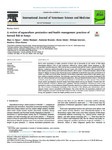| dc.description.abstract | Warm water aquaculture is widely practiced in Kenya and is dominated by the culture of Nile tilapia (Oreochromis niloticus) (75% of total production) followed by African catfish (Clarias gariepinus) at 18%. Aquaculture started in Kenya in 1920’s and has been on upward trend until 2014 when it peaked at 24,096 MT. However, production reduced drastically in the past 3years, with 14,952 metric tonnes (MT) reported in 2016. Most farmers practice earthen pond based semi-intensive culture system. Commercial intensive culture of Nile tilapia (O.niloticus) in cages in Lake Victoria has grown significantly in the last fiveyearswithaproductionof12 million kg of fish every cycle (about 8months). Re circulation aquaculture system (RAS) is also gaining popularity mainly in intensive hatcheries. The freshwater cages have been marred by increasing frequencies of fish kills with obvious financial and environmental implications. Although limited information exists on fish disease outbreaks across the country, certain well known diseases in farmed fish have been reported. These include; fungal, mainly saprolegniasis, bacterial, mainly hemorrhagic disease and pop-eye diseases. Parasites have also been documented in farmed O. niloticus and C. gariepinus. Although prophylactic treatments are used in some hatcheries in order to prevent infections, limited bio-security measures are in place to prevent diseases in farmed fish. This is because of inadequate knowledge of the economics of fish diseases, poor infrastructure and inadequate human resource specialized in fish diseases. This review describes the aquaculture production and health management practices of farmed fish in Kenya in order to document actions required for effective monitoring and regulation of future fish health problems across the country. | en_US |

